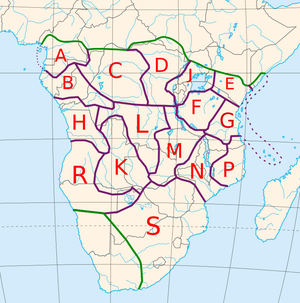Guthrie classification of Bantu languages
| Bantu | |
|---|---|
| Geographic distribution: | Africa, from approximately the equator south |
| Linguistic classification: | Niger-Congo Atlantic-Congo Benue-Congo Bantoid Southern Bantoid Bantu |
| Subdivisions: | Zones A–S |
 The approximate locations of the sixteen Guthrie Bantu zones, including the addition of a zone J The approximate locations of the sixteen Guthrie Bantu zones, including the addition of a zone J | |
The 250 or so Narrow Bantu languages are conventionally divided up into geographic zones first proposed by Malcolm Guthrie (1967–1971). Only Guthrie's Zone S is considered to be a valid genealogical group; since then a Zone J has been set up as another possible genealogical group. The list below reflects Guthrie as updated by Maho (2009). Not included in detail are the Northeast Bantu languages identified by Dahl's Law, which cuts across the Guthrie system. Individual languages are also not listed below if they are covered in dedicated articles on lower-level groups, such as Southern Bantu (Zone S). Some obscure languages are not included, especially if they do not have an iso3 coding for identification, or are widely classified as dialects of languages which are listed.
Note that Ethnologue made multiple changes to Guthrie in an attempt to make the classification more historically accurate. However, the changes are inconsistent, and other than the removal of some of the Zone A languages to Mbam, Ethnologue has not been followed here, though it is publicly available online. (See link below.)
Bantu has long been divided into Northwest Bantu and Central Bantu branches based upon tone patterns, but there is little agreement as to which Guthrie zones (or which parts of zones) should be in either, and that dichotomy has not been followed here.
Zone A
S Cameroon, Equatorial Guinea, N Gabon
Zone A is sometimes considered Northwest Bantu. Guthrie's A60 and part of his A40 have been moved to the Bantoid Mbam languages.
Zone B
S Gabon, W Congo, W DRC–Congo
Zone B is sometimes considered Northwest Bantu.
Zone C
NE DRC–Congo, N Congo
Zone C is sometimes considered Northwest Bantu, sometimes Central Bantu.
Zone D
NE DRC–Congo
D10, D30, the first line of D20, and some of D40 are sometimes considered Northwest Bantu, the others Central Bantu.
Zone E
Kenya, apart from Swahili
Zone F
W & C Tanzania. This is demonstrably not a valid group. Sukuma–Nyamwezi, for example, are part of Northeast Bantu.
The Isanzu language is sometimes classified as F30, sometimes thought to be a remnant of the Bantu languages spoken in the area before F-zone languages arrived.
Zone G
E Tanzania, Comoros
For other branches, see Northeast Coast Bantu (part of Northeast Bantu)
Zone H
NW Angola, W Congo
H10 and H40 are sometimes considered Northwest Bantu, the others Central Bantu.
Zone J
Uganga, Rwanda–Burundi, nears lakes Kivu & Victoria
See Great Lakes Bantu. (Part of Northeast Bantu.)
Zone K
E Angola, W Zambia
(K20 Lozi is now classified as Southern Bantu)
Zone L
S DRC–Congo, C Zambia
Zone M
E Zambia, SE DRC–Congo
Zone N
Malawi and surrounding areas, C Mozambique
Zone P
NE Mozambique, SE Tanzania
Zone R
SW Angola, N Namibia, N Botswana
Zone S
South Africa, Botswana, Zimbabwe, S. Mozambique.
Zone S is considered a valid group beyond the Guthrie system and is covered at Southern Bantu languages.
See also
References
External links
Retrieved from : http://en.wikipedia.org/wiki/Guthrie_classification_of_Bantu_languages#Zone_M